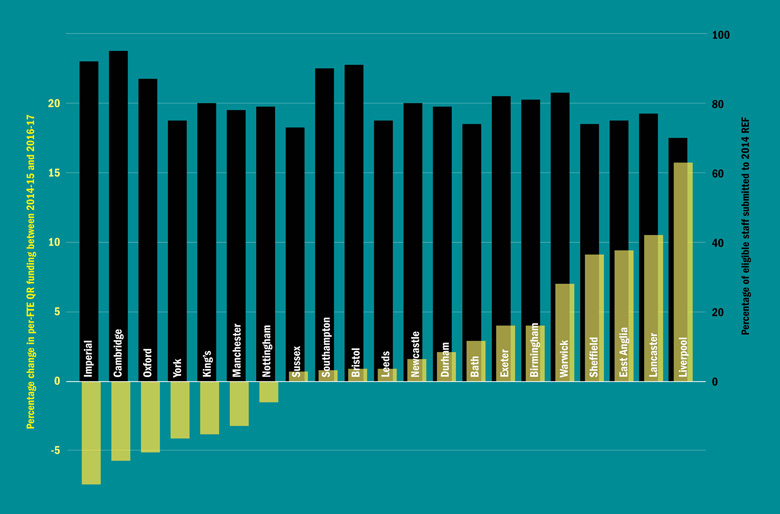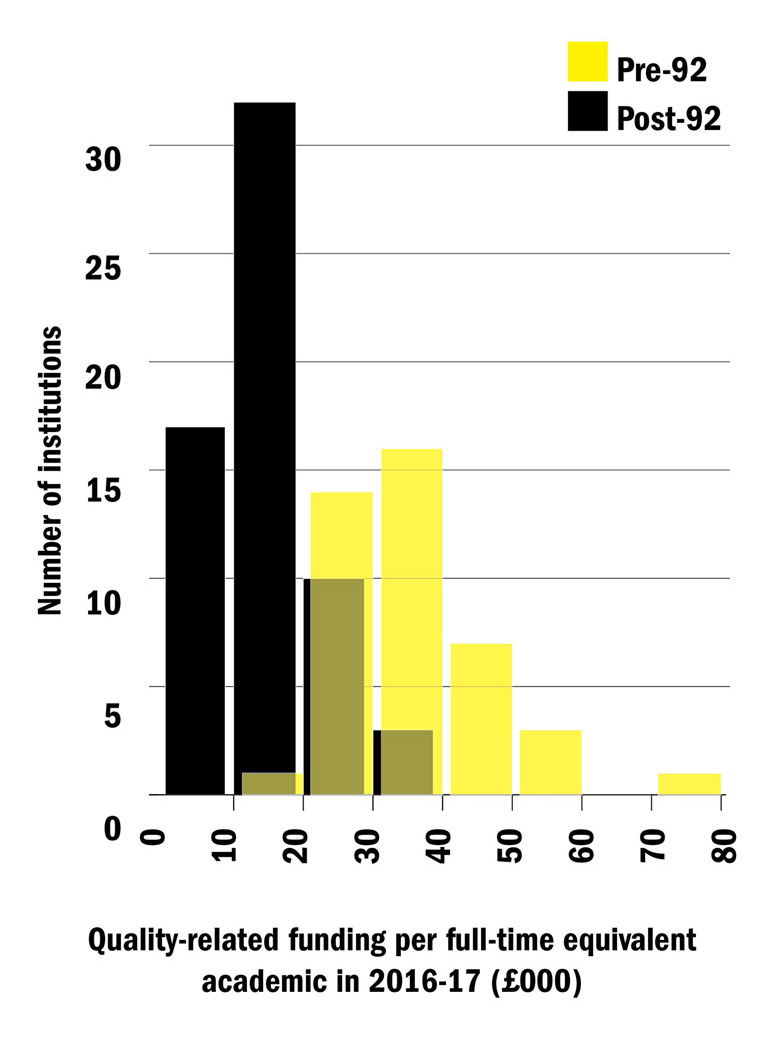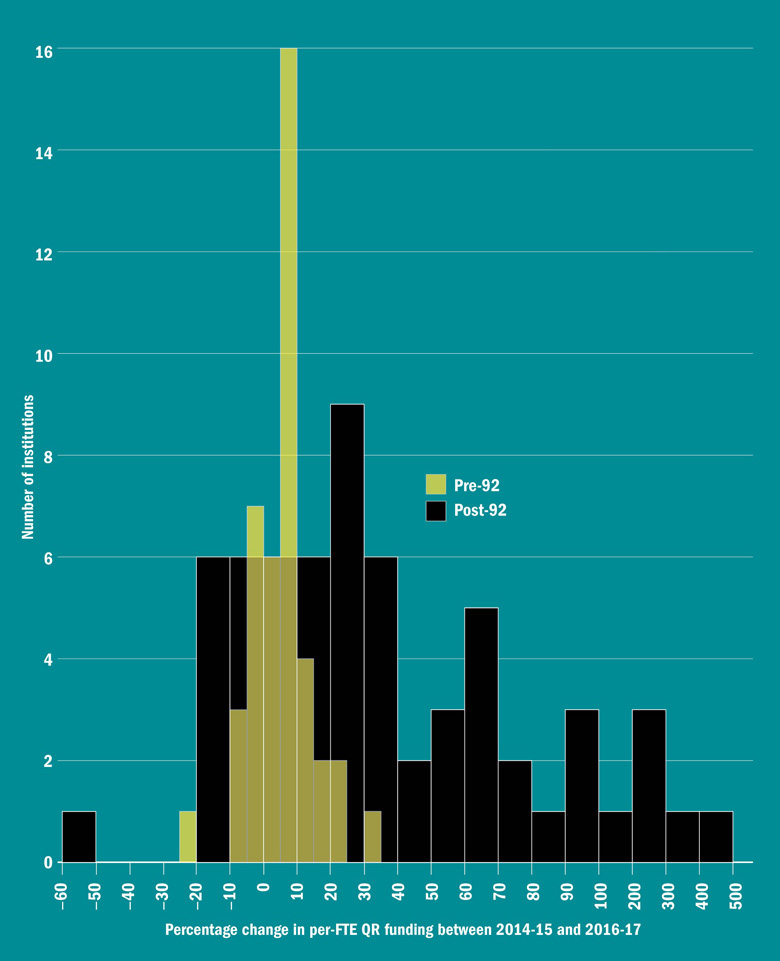When our institution, Lancaster University, was founded during the “plate-glass” expansion of the 1960s, it was part of a UK higher education system that catered to an elite 4 per cent of the eligible population. Virtually all costs, for both teaching and research, were covered by the government, and it was unquestioned that all university teaching should expose students to the latest thinking across disciplines, best expounded by active academic researchers.
Only 50 years later, 45 per cent of the eligible UK cohort attends university, while only between 25 and 30 per cent of the operating costs of higher education institutions are covered by public funds, and funding for research and tuition is not keeping up with inflation.
This state of affairs is the result of an increase in demand for undergraduate education that continued well beyond the 1960s, especially after the removal of the binary system in 1992. Such expansion implies levels of public investment that are difficult to justify given the huge national public sector deficit that has steadily grown since the 2008 financial crisis. When you also factor in the government’s ideological commitment to market-driven mechanisms, it is not surprising that austerity measures were followed by a large increase in student fees and the removal of student number caps; these transfer much more of the burden of managing increasingly constrained and uncertain budgets from the government on to universities and their students.
We certainly do not argue for a return to an elitist system; Lancaster’s widening participation record should leave no doubt as to our commitment to making higher education open to all those who can take advantage of it. However, we do believe that it is time for an honest and open debate about how meeting the increased demand for knowledge and skills can be squared with a sustainable funding model. Many of the issues are relevant to the global higher education landscape, and there are important international perspectives to a broader discussion of the UK context (in particular, reflections from the US have helped to form our thinking). But in what follows we focus on the domestic challenges, which we believe are particularly urgent at this point in time.
Most conversations about the massification and marketisation of UK higher education focus on the increasing reliance of universities’ budgets on tuition fees and concerns around the cost to the public purse of the projected growth of loan defaults (to which the government responded in November’s Spending Review by somewhat controversially freezing the repayment threshold). Moreover, the new perception of students as paying customers is heightening public scrutiny of the return on the investment that society is making in higher education. In particular, concerns about graduate employability in some specialised sectors raise questions about the relevance of what our students learn to prepare them for the rapidly changing workplace.
But the deeper problem that challenges research universities is that the expansion of higher education has come hand in hand with a commensurate increase in research activity that, in the context of our current system, is not financially sustainable. This critical fact is generally not appreciated outside academic circles, and is sometimes misunderstood even within them. According to the Higher Education Funding Council for England’s latest Financial Health of the Higher Education Sector report, the plain fact is this: in 2013‑14, there was an £883 million gap between the costs that English universities incurred – much of it research costs – and the amount that they were able to recover. The underlying trends identified in the report suggest that this deficit is likely only to widen over the next few years.
In an age in which the competition for top researchers is increasing and regulatory and reporting burdens are growing, the full costs of research can be met only by recruiting more full-fee-paying students. This major source of tension between research and teaching in research universities raises concerns about the long-term sustainability of the system. While a contribution from tuition fees to the research mission is entirely justifiable in a research-led teaching environment, there is increasing pressure in the opposite direction: to spend tuition fees on only the most directly targeted services and facilities for teaching.
Change in post-REF quality-related research funding for a representative group of research-intensive universities in England
To make the discussion about sustainability less abstract, let us consider the “model” academic, whose working life is split in a 40:40:20 ratio between teaching, research and “service”. What does the notional 40 per cent devoted to research “cost” the university? Apart from the direct employment costs, there are indirect and estates costs. Although these are wrapped up in jargon, they are very real, and include the cost of the underpinning building maintenance, heating and lighting and the use of the library and the IT network. They also include the costs of meeting the increasing compliance and regulation agenda. Even with recent drives to enhance efficiencies, other political pressures, such as those for more open access to research results and data, are increasing the total costs of carrying out research. We would conservatively estimate the cost of the research activities of, for example, a relatively junior social sciences professor at Lancaster to be £50,000 a year.
So how does this get paid for? The UK’s long-established dual-support system is envied throughout the world and, by many measures, has been a huge contributor to making UK research among the most successful and cost-effective in the world. It consists of the “quality-related” (QR) block grant, distributed on the basis of the results of the research excellence framework (REF), and the project grants distributed by research councils according to a rigorous peer-review process. But while the latter bodies are the most “generous” among grant funders (which also include an array of charities and foundations), they still do not meet the full cost of the projects they fund. So even if our imaginary social sciences professor contributes to a strong departmental submission to the REF and lands a research council grant that directly funds five hours of their time every week (significantly above that of the average in social science), the combined QR and research council grant award will generate only £34,000 a year towards the research element of their time. This leaves a deficit of £16,000 for the university to fund.
Of course, the situation varies according to discipline. For a relatively junior physics professor, the more generous QR allocation offsets the increased costs such that the physicist’s research activity would cost the university only £6,000 – although that deficit grows rapidly as the staff member devotes more time to research.
In fact, no matter how much additional grant funding a researcher could realistically secure, none of the primary funding sources fully covers the true cost of research. In addition, the growth of undergraduate teaching has created a larger pool of academics with the capacity and desire to do research, forcing everyone to take a smaller slice of the pie. According to figures from the Higher Education Statistics Agency, between 2004 and 2014, the number of academics on teaching and research or research-only contracts at English universities rose by 25 per cent, but QR funding has increased by only 15 per cent: a decrease per full-time equivalent academic of 8 per cent – or 33 per cent when inflation is factored in.
This discrepancy was compounded by the 2014 REF, which saw significant increases in the volume of top-rated research to which funding is linked. Examining a representative selection of research-intensive universities in England (see figure above) makes this clear: the changes in the QR funding allocated per full-time equivalent academic before and after the REF are only modest and, in some cases, even negative, making the research endeavour less sustainable once the real-terms rise in costs has been considered.
This is the inevitable effect of treating all universities within the same dual-support system for research. Newer, non-research-intensives are entrepreneurial in playing the “REF game” and have more room for improvement than already outstanding institutions do. In a zero-sum game, the latter thus see decreases in QR allocations.
The sustainability of university research is further eroded by the research councils’ move in recent years – in response to their flat-cash budgets – to ask universities for increasing levels of direct “contributions” to larger grants, such as directly funding PhD students in doctoral training centres and contributing towards equipment costs. This forces universities to dip into their QR pot, further undermining its core purpose of underpinning the research environment and underwriting promising but risky and untested ideas.
Current QR funding levels
In the absence of other resources, teaching funding comes under pressure, locking universities’ research and teaching missions into a tug of war and fuelling a perception that teaching may be short-changed (a perception that is driving the government’s establishment of the teaching excellence framework, as set out in its recent Green Paper on higher education). Anyone wondering where all this could lead would do well to reflect on the situation in the US, which lacks a national QR funding stream. Universities with small endowments are left to plug the gaps in their research sustainability with increases in tuition fees that, particularly in private institutions, are becoming exorbitant by any measure: an unsustainable situation in the long-term.
In the past, concerns about the sustainability of the UK system were mitigated by an expectation that the government would always intervene to avert disaster. But the more recent signals suggest a less optimistic future in which bailing out failing institutions will not be on the political agenda. The knock‑on consequences to the sector of the cost of borrowing, via direct loans and the pension covenant, do not appear to have been fully thought through yet. The Green Paper also signals that, in other ways, the government intends to become more hands-on. This, inevitably, will come with frequent shifts in policies, increasing uncertainties and making longer-term strategic planning difficult, particularly for small and medium-sized institutions. In this uncertain climate, a number of universities that aspire to distinguish themselves in research but have not yet developed sufficiently robust and diverse income portfolios may already be functioning too close to the break-even point to be viable in the long term within the current system.
In addition, through the REF’s new focus on wider societal impact, the government is directly challenging universities to adapt their research priorities in real time to societal needs. Many academics view such interventions as violations of academic freedom that fly in the face of their historic mission to create and disseminate knowledge for its own sake. Increasing governmental, financial and societal pressure is also creating a “managerial” culture, and a growing mismatch between the quick response to financial and political realities expected of university administrations and the much slower and more unpredictable course of academic life. More important is the fact that, driven by increased competition and the sector’s obsession with rankings and performance indicators, some institutions have used rather crude metrics to evaluate staff – as documented by an increasing number of stories in Times Higher Education. This negatively affects academic morale and fuels growing tensions between academics and administrators.
Chipping away at such “them versus us” attitudes is perhaps the crucial first step to re-establishing a university community with a common identity, built upon common aspirations. We must move away from paying lip service to “shared governance” and bring those principally responsible for delivering the mission-critical activities – research and teaching – into the centre of conversations about how to address substantive issues. To that end, each university should charge a representative group of academic staff, students and administrators with developing a shared understanding of the challenges around the sustainability of research, and with conceiving and implementing new models to address them. While any initial discussions of non-incremental change must involve top-down action in convening the appropriate group and in defining the range of actionable possibilities, it is ultimately the group of staff that must develop the path forward. To implement fundamental and sustainable solutions, they must share in the ownership of the change process and become the main conduit in communicating its rationale, building a consensus within the entire community.
However, reforming academic institutions is like redesigning the train one is travelling on. Any substantive change should be developed and tested only if minimal interference can be ensured with the delivery of the university’s mainstream mission. So the changes must generally be limited to a tiny number of substantial pilot projects, whose overheads should be small enough to be virtually invisible to the rest of the university.
Indeed, it is often better to develop and test risky ideas outside institutional silos. The reason that corporatisation is permeating every level of UK universities is that much of the financial accountability passed down from the government is ultimately borne by faculties and departments. But focusing responsibility for sustainability at this level tends to create disincentives to interdisciplinary collaborations, and often encourages short-term thinking and “safe bets” that do not take advantage of the talent and innovative potential of the institution as a whole.
Change in post-REF quality-related funding for the UK higher education sector
Universities must address other internal issues, too. They cannot abrogate responsibility for quality and efficiency by simply reacting to externally imposed performance metrics. They must become proactive in developing honest and transparent ways of assessing quality across all their activities by collecting and evaluating quantitative and qualitative data. They should focus on a long-term vision of institutional quality and impact – with an eye to institutional identity and disciplinary differences – that yields clear expectations of outcomes for both individual and collaborative educational and research efforts. And research universities must resist the Green Paper’s thrust towards increased compartmentalisation of universities’ teaching and research missions, and must be aggressive in articulating the benefit of enquiry-led education and experiential learning, using thoughtful metrics and examples.
More radical measures should also be considered. For instance, Lancaster is establishing new structures that support university-wide interdisciplinary research institutes on a similar footing to traditional academic units. We are also creating 20 new early career posts that will be affiliated to both an institute and a standard academic department, and are also experimenting with new budgetary models that force closer and more strategic collaborations among faculties and departments. The role of deans and department heads needs to be shifted from caretaker of budgets that are largely already spoken for to intellectual leaders working together to identify mutual opportunities and define ways of sharing resources and credit.
But substantive and sustainable change must ultimately be systemic. It is not enough for the government to rely on market forces to eventually layer the system into institutions that serve different educational goals. The increasing and unsustainable pressures imposed by the growth in the number of universities on a national research ecosystem that is already underfunded by international standards needs to be addressed upfront. The government must provide incentives and support systems for a goal-oriented layering of the landscape that, from the start, increases the international competitiveness of the system by improving the variety of educational and professional opportunities that it offers to students.
Universities – some of which may consider themselves to be sufficiently financially secure not to feel an urgent need for change – must seek dialogue with both industry and government in a bid to forge a shared vision of a long-term, sustainable funding model for higher education based on a more diversified and robust portfolio of resources. Stronger integration of funding for research and postgraduate training, emulating the success of the US graduate school model, would enhance both training effectiveness and the impact of our research enterprises, particularly in interdisciplinary areas. The government must also provide incentives for greater collaboration and sharing of facilities among research-intensives, and support universities in their efforts to incorporate private sector partners into their fabric.
But the basic tenets of a university must not be compromised. The REF and the TEF must be integrated, and the resource allocation model must recognise the need for balancing intrinsically conflicted elements of the higher education ecosystem: societal versus private value; collaboration versus competition; tradition versus dynamism; applied versus blue-sky research; and regulation versus market forces.
These are all highly complex issues, but we cannot continue to ignore them. The future of a successful UK higher education system is at stake.
Andrei E. Ruckenstein was interim pro vice-chancellor for research at Lancaster University for part of 2014, having previously been founding vice-president and associate provost for research at Boston University, where he is currently professor of physics. Mark E. Smith is vice-chancellor and Nicola C. Owen is chief administrative officer at Lancaster.
后记
Print headline: We can’t go on like this







